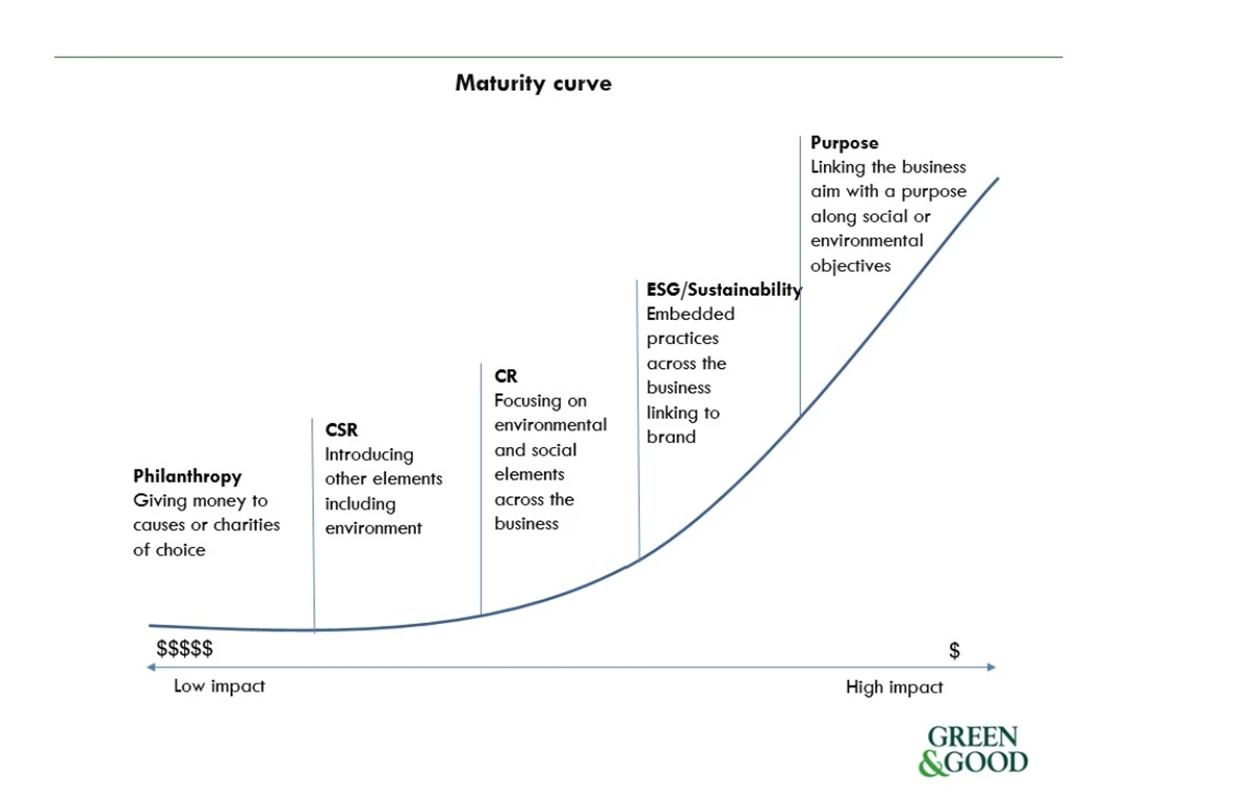Contents
Every organisation sits somewhere on the ESG maturity curve. If you’re not sure where your business currently falls, start here.
The ESG Maturity Curve

The good news? No matter where you sit on the curve, you don’t need sweeping reforms to progress. Often, small, targeted training changes can deliver the momentum to take your ESG efforts to the next level.
Here, we’ll walk through each progression along the curve, highlighting the opportunities and sticking points you might encounter along the way. For every stage, you’ll see a real-world example of what ESG looks like in practice, the training that can help your employees move along with you, and the results that advance your organisation forward.
From philanthropy to corporate social responsibility (CSR): Connecting community giving to business strategy
Organisations that sit at the philanthropy stage do tend to support charities or causes, but these efforts often feel disconnected from overall business strategy. Employees may see them simply as “tick-the-box” compliance exercises or PR stunts.
Example: company donates laptops to local schools, but without communication and training, staff members don’t know how this relates to the organisation’s broader commitment to help nurture the next generation of talent and build good will and stronger ties in the community.
Training focus: to move on to the CSR sweep of the curve, consider rolling out such courses as ESG Fundamentals, Community Relations and Introduction to Social Impact to show your employees how giving back to the community lines up with long-term social and business objectives.
Result: Employees gain understanding into how giving back links to real social impact, such as supporting young people who may one day become colleagues, leaders, or partners. They can clearly explain this connection both internally and externally. And your company moves towards the CSR point on the ESG maturity curve.
From CSR to corporate responsibility: Breaking down silos with robust reporting
If you find yourself at the CSR stage, ESG initiatives are in place and increasingly align with core values, such as promoting workplace diversity and advocating for ethical sourcing. Yet these efforts can still sit in pockets of the business, limiting visibility and making it harder again for employees to see how their contributions connect to broader ESG goals.
Example: A facilities team diligently tracks energy use but doesn’t know how the data feeds into ESG disclosures or investor communications.
Training focus: Courses such as Environmental, Social and Governance Reporting Requirements and Business Ethics and Values give staff confidence in reporting frameworks and help them avoid missteps.
Result: Accurate, consistent communication and training across teams transform ESG from scattered initiatives into a unified business commitment. With policies and practices that uphold ethical standards, responsible sourcing, and transparent governance, ESG becomes a lever for your company’s reputation, risk management, and talent retention – and shifts it to the corporate responsibility point on the ESG maturity curve.
From corporate responsibility to ESG/sustainability: Driving innovation
At this stage, organisations have moved past ‘doing good’ into actively managing risk and aligning ESG with operations. The challenge, then, is helping employees see ESG as a driver of innovation.
Example: A procurement team wants to reduce supplier risks but isn’t confident in assessing sustainability practices or identifying opportunities to embed ESG into contracts.
Training focus: Pairing such courses as Sustainable Procurement and Net Zero Supply Chains with Net Zero and Your Carbon Footprint equips staff to effectively audit and make informed, proactive choices.
Result: Armed with this knowledge, employees can spot more creative, innovative ways to cut carbon, reduce waste, and strengthen supplier practices. As sustainable thinking becomes embedded in everyday decisions, your company builds more resilient supply chains and can advance to the ESG/sustainability point on the maturity curve.
From ESG/sustainability to purpose: Communicating with authenticity
By the sustainability stage, ESG is well and truly embedded in your long-term strategy. The next leap is making sure employees can communicate initiatives authentically and avoid the reputational risks of greenwashing.
Example: The marketing team wants to promote new sustainable packaging but worries that their messaging might overpromise or be misinterpreted.
Training focus: Courses such as Embracing the Circular Economy and Becoming a Green Business provide the knowledge and context staff need to communicate initiatives with clarity.
Result: Once you’ve reached this pinnacle of ‘purpose’, ESG is inseparable from your company’s identity. Employees understand the nuances and communicate with authenticity, becoming trusted ambassadors who reinforce your organisation’s leadership position. By staying adaptive and ahead of fast-moving regulations and global expectations, your business will continue to set the pace for the industry
The bottom line
Moving up the ESG maturity curve doesn’t require a sweeping organisational overhaul – just the right training at the right time. By matching your ESG ambitions with targeted learning, you can strengthen communication, secure internal buy-in, and empower employees as authentic ambassadors for change.
Explore Kineo’s ever-evolving suite of ESG courses to take your next step forward.
Every ESG journey is unique. Chat with our team to find the solution that works best for your business. We’d love to help.





.svg)






